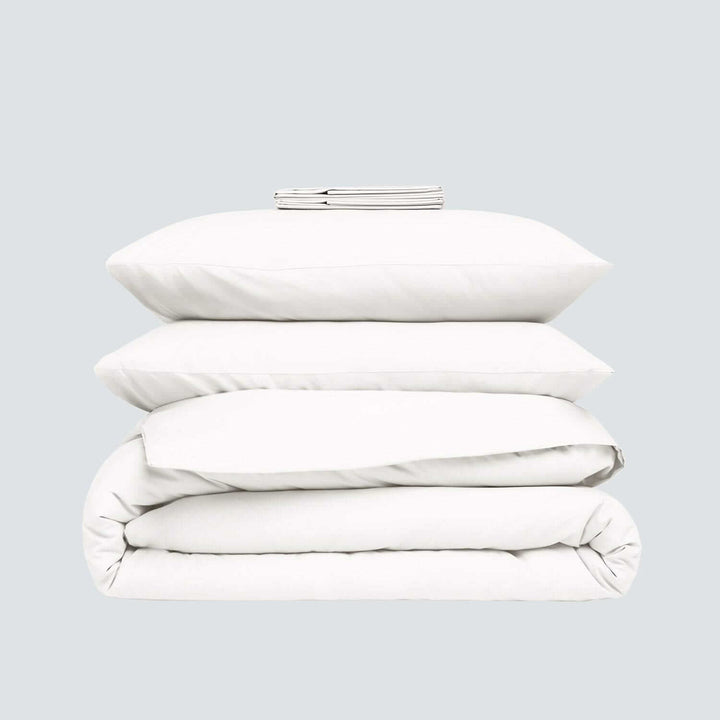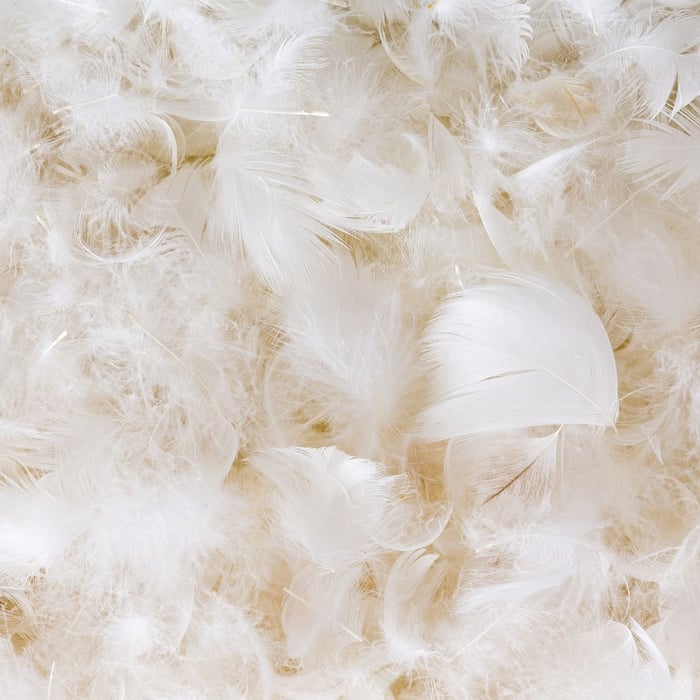Table of Contents
- The Quick Answer
- What’s Really Hiding in Conventional Bedding
- The Link Between Chemicals and Allergic Reactions
- Why Natural Fibers Make a Difference
- The Myth of “Hypoallergenic Synthetics”
- The Regenerative Advantage
- How to Identify True Chemical-Free Bedding
- Real-World Results: Better Sleep and Fewer Reactions
- Summary: Better Sleep Starts With Cleaner Materials
- FAQs on Wool Duvet Inserts, Comforters & Sustainable Bedding
The Quick Answer
If you wake up with a stuffy nose, itchy eyes, or headaches, your bedding might be the culprit.
Chemical-free bedding isn’t just a lifestyle choice — it’s a health necessity for allergy sufferers. Organic, natural fibers like regenerative wool and cotton are free from the harsh residues, dyes, and finishes found in conventional bedding, helping you breathe easier and sleep deeper.
Imagine sinking into sheets that actually breathe with you — no chemical smells, no mystery coatings, just pure comfort. It’s the kind of sleep that feels like fresh air after rain, where your body finally exhales and your mind follows.
For many allergy sufferers, that first night under chemical-free bedding is a revelation — the sneezing slows, the skin settles, and mornings feel lighter. Because when your sleep space is free of toxins, it becomes more than just a bed. It becomes a sanctuary — a place where restoration begins, one clean breath at a time.
Learn More in our complete guide to non-toxic, allergy-free sleep
What’s Really Hiding in Conventional Bedding
Most people don’t realize how much chemical processing goes into typical “soft” sheets and duvets.
Common Culprits:
Formaldehyde – used in wrinkle-resistant finishes.
Synthetic dyes & perfumes – can trigger skin irritation and asthma.
Flame retardants & PFAS (“forever chemicals”) – linked to hormone disruption.
Pesticide residues – found in non-organic cotton.
These compounds don’t just wash away — they linger in the fibers you sleep on for eight hours a night. Over time, that exposure can worsen eczema, rhinitis, and respiratory allergies.
The Link Between Chemicals and Allergic Reactions
Your skin is your body’s largest organ — and it absorbs more than you think. When chemical-treated fibers rub against your skin, off-gassing and friction can trigger immune responses.
Symptoms Commonly Reported:
Morning congestion or sore throat
Itchy, irritated skin or scalp
Red eyes and watery sinuses
Fatigue from poor overnight oxygen flow
Even mild sensitivities can become chronic when you’re exposed nightly. That’s why choosing chemical-free bedding made from natural, breathable fibers makes such a noticeable difference.
Why Natural Fibers Make a Difference
🌿 Regenerative Wool: The Natural Air Purifier
Wool fibers actively absorb and neutralize volatile compounds and odors in the air.
Naturally hypoallergenic and antibacterial
Repels dust mites and mold
Regulates moisture — preventing the damp environments allergens love
Wool also supports temperature-regulating bedding, helping your body maintain balance while reducing sweat (a common allergen magnet).
Organic Wool Comforter | Made in New Zealand, Breathable All-Season Comfort

$342.00
$380.00
Sleep naturally better with our organic wool comforter Unlike down or synthetic comforters that trap heat, our spun wool design wicks away moisture and prevents overheating, so you stay cool & dry. Designed for deeper sleep with a gentle weight… Read more
🌱 Organic Cotton: Gentle on Skin, Kinder to Earth
Unlike conventional cotton, organic regenerative cotton is grown without pesticides or synthetic fertilizers.
Soft, breathable, and durable
Free of microplastics and toxic finishes
Ideal for sensitive or eczema-prone skin
Together, these two fibers form the foundation of sustainable duvet materials that are both allergy-safe and planet-friendly.
Regenerative Organic Cotton Sheet Set – Soft, Breathable & Sustainable

$189.00
Softer Sheets. Cleaner Sleep. Our organic cotton sheet set are simply better for the earth, and for your sleep. Grown on low-impact regenerative farms that actively heal the soil, our cotton is then woven and finished responsibly. This process eliminates… Read more
When comparing bamboo vs wool bedding, it’s easy to be swayed by marketing that claims bamboo is the ultimate eco choice. While bamboo feels silky and light, most bamboo fabrics are chemically processed into viscose, which strips away their natural properties. Regenerative wool, on the other hand, stays true to its roots — breathable, biodegradable, and genuinely kind to both your skin and the planet.
The Myth of “Hypoallergenic Synthetics”
Many products labeled “hypoallergenic” are made from polyester or microfiber — essentially refined plastic fibers.
While they resist dust mites initially, they also:
Trap heat and moisture
Attract static and airborne particles
Shed microplastics into your lungs and waterways
That’s why natural, chemical-free bedding performs better for long-term health. It doesn’t just block allergens — it removes the source.
The Regenerative Advantage
At Antipodean Home, our bedding goes beyond organic — it’s regenerative. That means every comforter and sheet set supports farms restoring soil health, biodiversity, and carbon balance.
When you choose regenerative wool, you’re not just protecting your health — you’re helping rebuild ecosystems across 3.7 million acres of New Zealand farmland.
That’s the difference between “doing less harm” and doing active good.
Sustainable & Regenerative Bedding Bundle | No More Night Sweats, Just Deeper Sleep

$598.40
$748.00
Cooler Nights & Deeper Sleep — Every Night Elevate your sleep with the only sustainable bundle crafted from regenerative New Zealand wool and organic cotton for true all-season comfort. These breathable, eco-friendly fibers naturally wick away heat and moisture to… Read more
How to Identify True Chemical-Free Bedding
1️⃣ Check Certifications
Look for standards and certifications like:
GOTS (Global Organic Textile Standard)
OEKO-TEX Standard 100
ZQ or ZQRX Wool (for animal welfare and land stewardship)
2️⃣ Read the Fiber Content
Avoid terms like “microfiber,” “performance blend,” or “wrinkle-free” — they often mean synthetic chemicals or coatings.
3️⃣ Smell and Feel
A faint “factory scent” or ultra-slick finish usually indicates chemical residue. True natural fabrics feel breathable, not slippery.
Real-World Results: Better Sleep and Fewer Reactions
Our customers often tell us the difference is immediate:
Fewer allergy flare-ups after switching to wool comforters for hot sleepers
Cooler, drier nights without synthetic sweat buildup
Noticeable improvement in skin clarity and morning congestion
Because chemical-free bedding allows your body to recover naturally, your sleep quality improves along with your immune resilience.
For those who tend to overheat at night, a wool comforter for hot sleepers offers the perfect balance of cooling and insulation. Unlike synthetics or down alternatives, wool actively draws heat and moisture away from your body, keeping your skin dry and your temperature steady. Wool bedding is a natural solution that supports deeper, uninterrupted sleep — without relying on chemicals or coatings to feel “cool.”
Summary: Better Sleep Starts With Cleaner Materials
Your bedding shouldn’t compromise your health.
Choosing chemical-free, sustainable duvet materials is one of the simplest ways to reduce allergens, protect your skin, and sleep more soundly.
Key Takeaways:
🌱 Go for organic, regenerative fibers — not synthetics or chemically finished fabrics.
🧼 Avoid “wrinkle-free,” “stain-resistant,” or “performance” labels.
🌿 Choose wool and organic cotton for true hypoallergenic performance.
😴 Experience deeper rest with temperature-regulating bedding.
💚 Support sustainable bedding that restores the planet, not depletes it.
Ready to Breathe Easier Tonight?
Experience naturally cleaner, restorative sleep with our Organic Regenerative Wool Comforter —
made in New Zealand for allergy-safe comfort and sustainable living.
FAQs on Wool Duvet Inserts, Comforters & Sustainable Bedding
Is chemical-free bedding really hypoallergenic?
Yes. Natural fibers like wool and organic cotton resist dust mites and mold without added treatments — making them ideal for allergy-sensitive sleepers.
Can I wash chemical-free bedding the same way?
Absolutely. Use mild detergent and cold water. For tips, see our Wool Care Guide.
What’s the best chemical-free option for hot sleepers?
A wool comforter for hot sleepers — it regulates body temperature and moisture better than synthetics or down.
Are chemical-free sheets softer?
Yes. Without harsh finishes, organic fibers retain their natural softness and breathability, improving over time.
How does it compare to bamboo or microfiber bedding?
Bamboo vs wool bedding may feel similar at first, but bamboo viscose is chemically processed, while wool is naturally temperature-regulating and sustainable.




